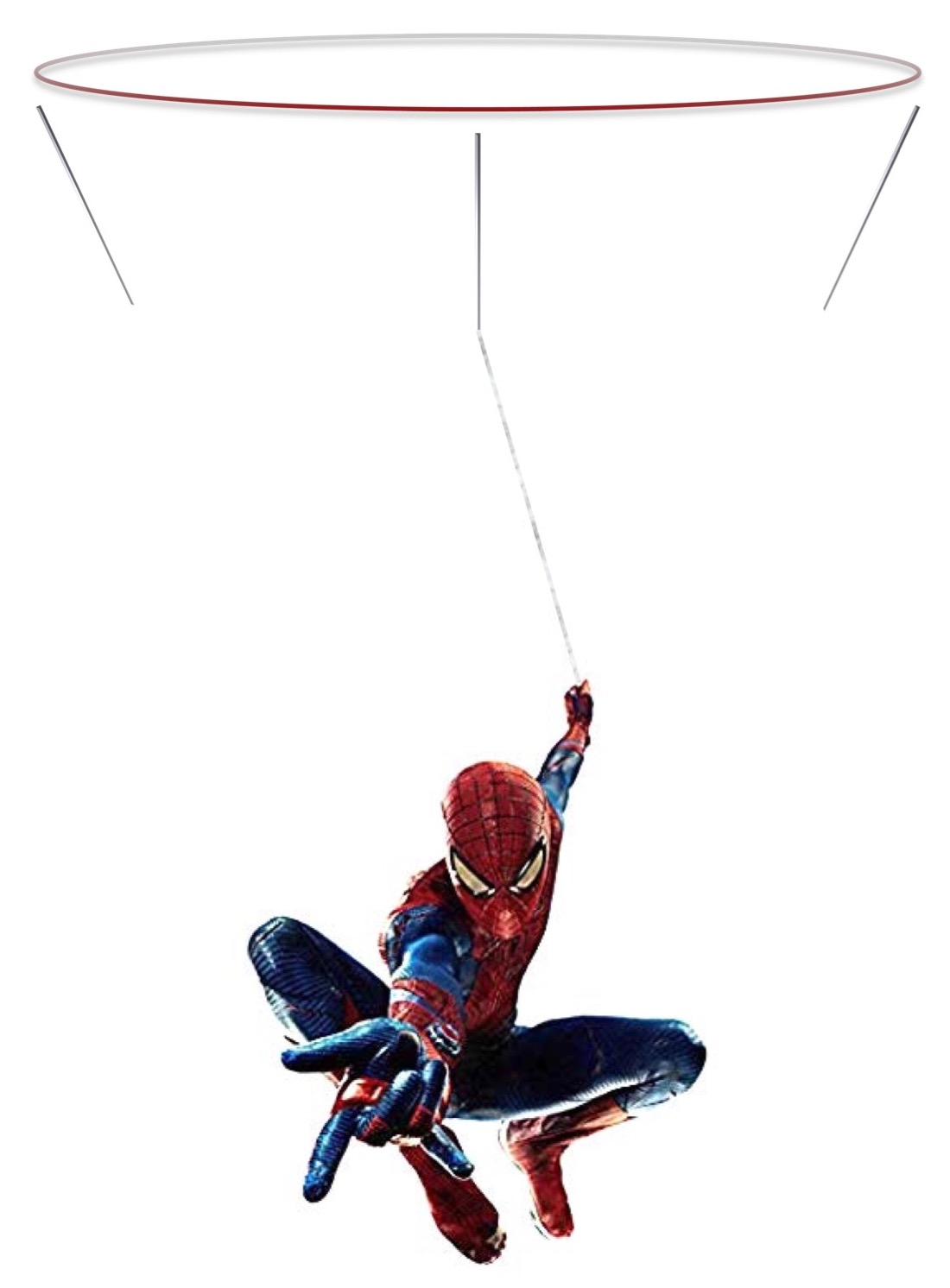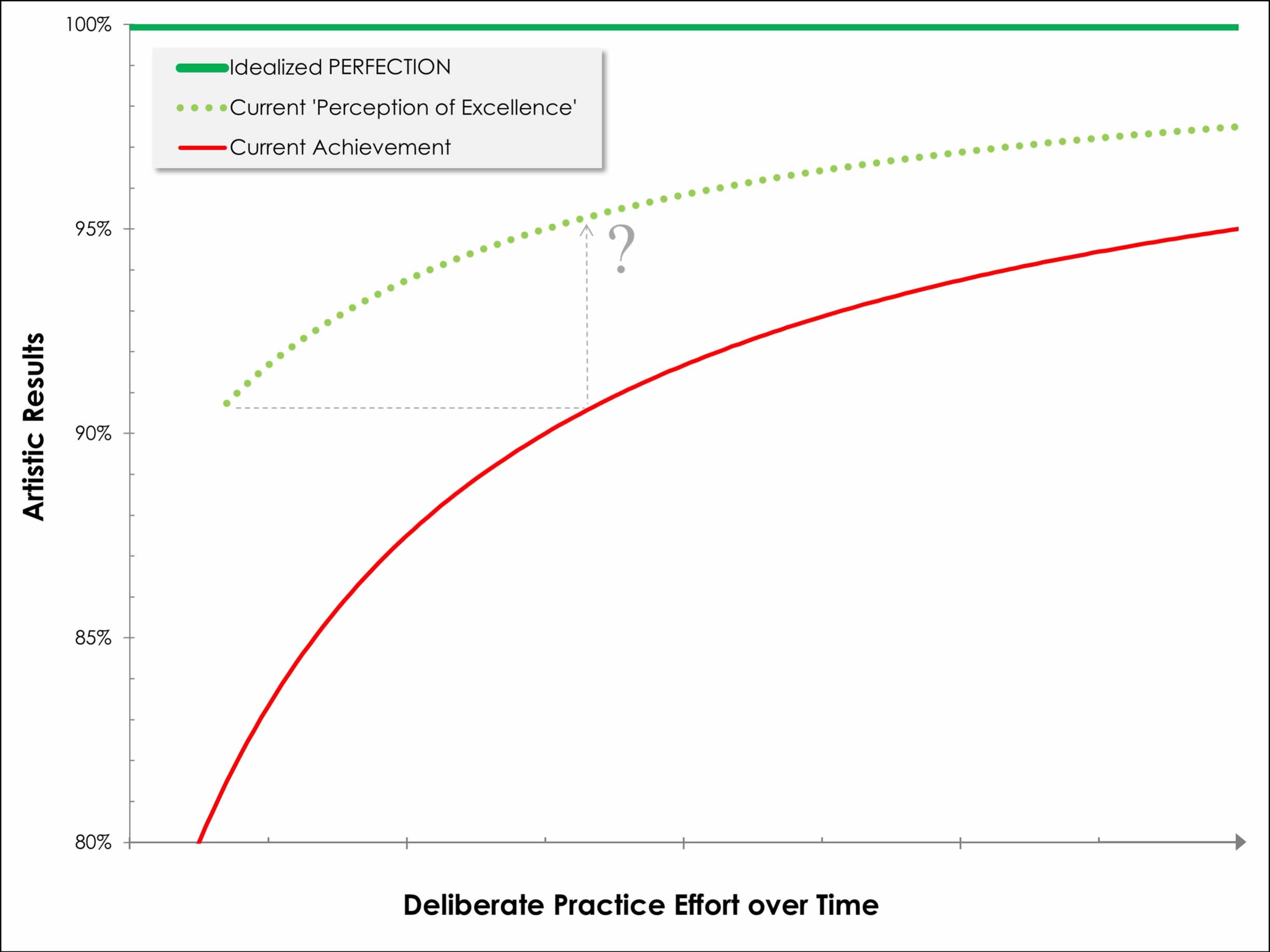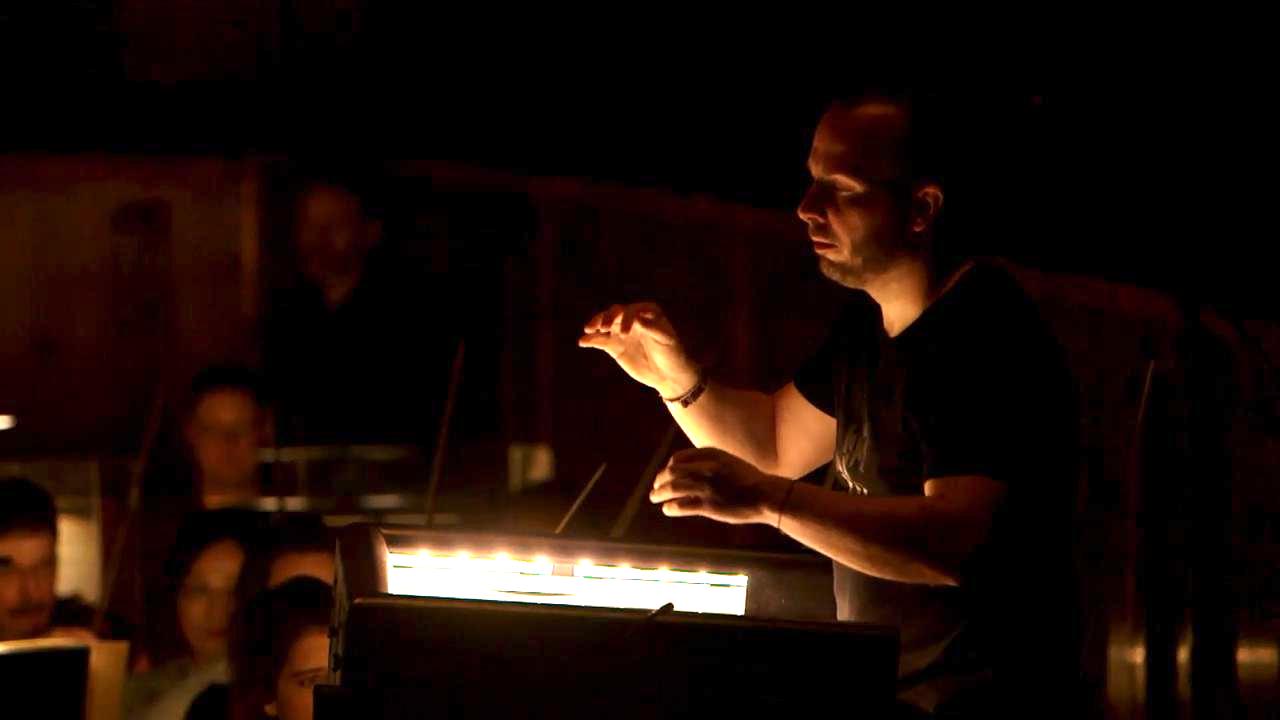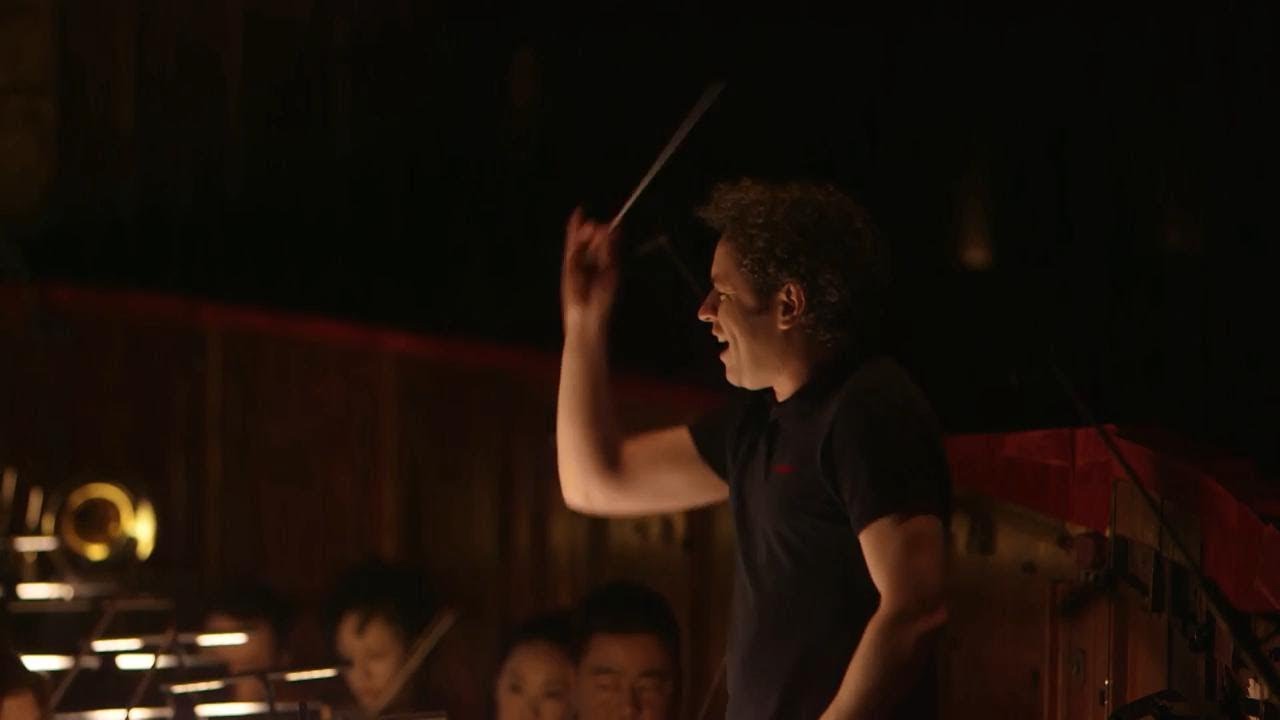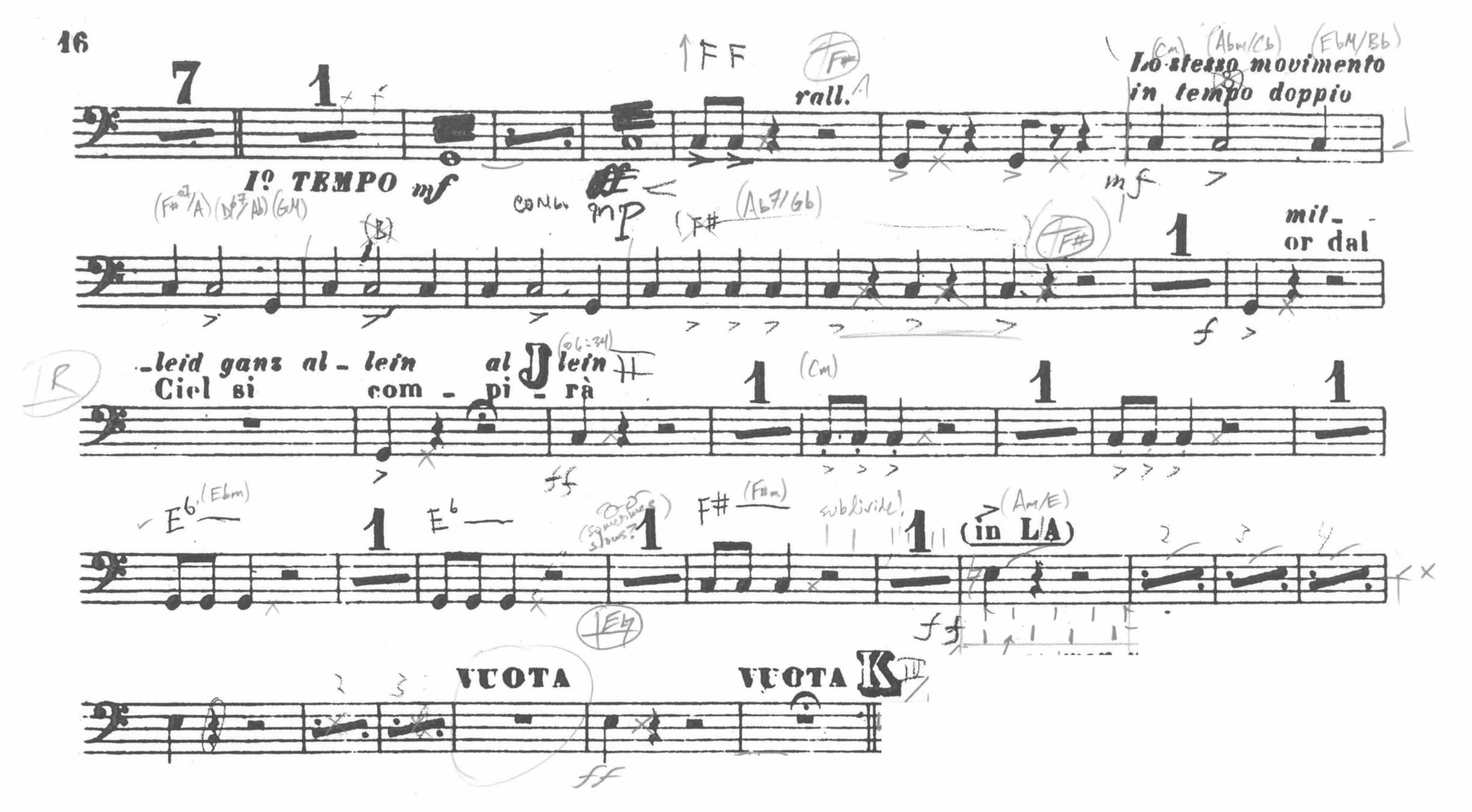(The Attributes of Deliberate Practice: Enhanced Perception)

In this instance, the CDs contained only six excerpts in the following order: Tchaik 4, Brahms 1, Mozart Magic Flute, Bartok Concerto for Orchestra, Verdi Don Carlo, and Beethoven 9. Those six excerpts were chosen to provide a concise yet comprehensive window into a candidate’s playing. And yet, for me, it was still overkill.
Now, a question for you reader: How much of the CD do you think I needed to hear before I was 90% sure of how I was going to vote on a candidate?
Three excerpts? Two excerpts?? Only one excerpt??!
Ummmm…no. You’d still be wrong. In fact, I really only needed to hear the first 5 measures of the first excerpt:

From those 5 measures, I got 90% of the objective information I needed about a player’s time, rhythm, intonation, touch, and ability to achieve balanced clarity and smoothness with their hands. Now, I certainly needed much more information than that to make decisions in later rounds. But as the saying goes, “Nobody wins in the first round”; early on, it’s about making big cuts based on objective criteria. And for that, I only needed about 10 seconds of music.
This may seem insane to you. This may seem incredibly unfair. This may even seem confoundingly arbitrary. But I assure you, from my side of the screen, it is none of those things. In fact, those decisions were easy to make, and in retrospect quite obvious. And it’s all due to the power of enhanced perception that comes with deliberate practice.
Perceiving More
In The Two Towers, as our heroic trio races across the plains of Rohan in hot pursuit of the Uruk-hai abductors, Aragorn shouts “Legolas! What do your elf eyes see?” When T’Challa drinks the heart-shaped-herb elixir, he gains the not only the Black Panther’s acute senses, strength, speed, and stamina, but also the extra-dimensional astral plane perception that comes with that vibranium-charged package. In both The Uncanny X-Men #451 and Wolverine Origins #9, Wolverine leverages his enhanced mutant hearing to detect subtle changes in a person’s heartbeat, thereby functioning as an adamantium-clawed lie detector. And the blind Daredevil’s hearing is so keen that he uses it as high-definition sonar and echolocation to map out 3D space.
The superpowers above are inherently genetic (Legolas), genetic mutations (Wolverine), or biotech-assisted gene therapy (Black Panther). But the origin story of Daredevil strikes a chord much closer to the power of deliberate practice to enhance perception. While Daredevil’s powers are described in the comics as “superhuman,” they are nevertheless grounded in the reality of human adaptive capacity: after Daredevil is blinded by a childhood accident, he develops extremely acute hearing. This is a fundamental truth of perception which relates to neuroplasticity — the ability for the brain to change, literally enhancing our perceptive abilities. Copious research into the boosted remaining senses of the blind and deaf has thoroughly established this principle. So it’s no wonder this is a core attribute of deliberate practice: musicians who put in enough hours develop virtually superhuman hearing.
In my previous post, I proposed an “obsession with continuous refinement,” noting that you really cannot have a goal of achieving perfection — or even excellence — because “excellence is a moving target”:
“From the red line of current achievement…we perceive ‘excellence’ as something way over our heads. We then put in deliberate practice time and effort, and move ourselves rightward, improving our artistic results. But when we arrive at where we thought ‘excellence’ was, we realize the target has shifted!”
It is a basic conundrum of artistic life that, upon making progress, you realize you always have further to go. I wrote “along the way, we’ve gotten pickier. Our standards have risen, and our concept of ‘excellent’ is now more refined and nuanced.”
But why? And how? I left that part unaddressed in my previous post, stating only that this is the reality for anyone who pursues music performance (or anything) at a high level. But why can’t we ever catch up to excellence? What is the mechanism of this Sisyphean pursuit?
The mechanism is neurobiological. It turns out that our brains’ neuroplasticity evolves several measurable adaptations as we invest thousands of hours of deliberate practice:
- The ability to know more from seeing and hearing less,
- Understanding the significance of indicators that most people don’t even notice,
- The ability to look further ahead, and
- Making finer discriminations than average performers.
Knowing More from Hearing Less
My Tchaik 4 CD-round anecdote is a textbook example of this phenomena in the world of deliberate practice research. In Talent is Overrated, Colvin explicitly cites that top performers “hear more when they listen…. Highly trained pilots and apprentice pilots were asked to listen to a dialogue between pilots and air traffic controllers, and then to choose a diagram that best represented the situation they had just heard being talked about. The well-trained pilots were twice as good.” And likely unsurprising for any readers of this blog, “musicians are much better than nonmusicians at detecting very small differences in pitch and loudness of notes. Everyone in these studies is hearing the same things, but through years of practice, some are perceiving more.”
But examples abound in areas far beyond music:
“Accomplished and novice drivers were tested for their reactions to hazardous situations; [the accomplished] didn’t react any faster than the novices, but they understood what they were seeing much more quickly. The novices remained fixated on the hazardous situation much longer than the experienced drivers did, trying to comprehend it. The better drivers got it right away and thus had more time available to respond.…
“[Similarly], police officers learn how to [overcome implicit bias and] decide in a split second whether to shoot. Quarterbacks learn to decide from very few cues whether to throw the ball, and if so, where.”
Next season, the Met Opera will be performing Philip Glass’s Akhnaten, a production which involves a host of first-rate jugglers onstage. In terms of enhanced perception, research has shown that “jugglers display similar abilities…. Good jugglers don’t need to see the whole path of the balls. When their vision is restricted, they can make the necessary adjustments as long as they can see just the apex of each ball’s trajectory. Though seeing very little, they see more than average jugglers and understand all they need to.”
From one perspective, this is just a basic evolutionary adaptation for survival; as human animals, we never have as much information as we want or need. Acquiring information requires resources. This was no less true in hunter-gatherer societies, but today this basically amounts to time and money. Making good decisions quickly and cheaply is a competitive advantage in every imaginable situation and industry. According to this perspective, then, deliberate practice leverages this evolutionary drive to make decisions most pertinent and critical to the field of music performance. Evolution looks for efficiency, and deliberate practice rewards it.
Ordinarily Unnoticed Significant Indicators
“Significant indicators” is an important term of deliberate practice research. In the context of enhanced perception, it relates to subtle variables you detect with any of your senses. Our fantastic new music director Yannick Nézet-Séguin conducted our recent run of Debussy’s Pelléas et Mélisande without using a baton, allowing him to shape the score’s subtle articulations and delicate atmospheres with highly precise hand gestures, ambidextrously emoting all the way down to individual finger joints. Those subtleties were probably invisible from the balcony or family circle, but conducting baton-less works wonderfully for this repertoire, and the performances were nothing short of sublime.
Similarly, Gustavo Dudamel recently conducted the MET Orchestra through an electrifying run of Verdi’s Otello, and one of my colleagues pointed out an aspect of his conducting that’s another perfect example of a significant indicator: most laypeople will watch a conductor and just see someone waving their hands in the air, but we musicians obviously depend on much more; specifically, the way different conductors define and shape the ictus of their beat patterns can dramatically affect an ensemble’s ability to line up rhythmically. And like the jugglers watching balls at the apex of their trajectory, the way Dudamel moves to and from the ictus conveys more than the actual definition of the point itself — we know where it’s going to be in advance. Along with a handful of other truly masterful conductors, Dudamel has calibrated the acceleration and deceleration of his baton to indicate both where and when the ictus is going to occur.
For musicians like us who are used to watching many different conductors, significant indicators like these makes it an easy joy to have Yannick or “the Dude” on the podium.
Significant indicators often relate to this sort of predictive capacity — the ability to anticipate and quickly respond to changing situations. Colvin illustrates another excellent example of this with respect to top-seeded tennis players, who possess the seemingly-preternatural ability to return blazing fast serves that ace amateurs. In the case of these top pros, it can seem like they’re predicting the future, knowing in advance where their opponent’s serve is going to land. Perplexingly, slow-motion replays reveal that these top players are frequently in motion before their opponent’s serving racquet even contacts the ball. How is this possible?
“Researchers showed tennis players films of opponents serving at them, and used sophisticated equipment to track precisely their eye movements. Average players focused on the ball. But in the brief period between the start of the serving motion and the moment when the racket hits the ball…the best players weren’t looking at the ball. They were looking at the opponent’s hips, shoulders, and arms, which foretold where they would hit the ball. The researchers then stopped the film at the moment of contact and asked the test subjects where the serve was going to go. The average players, being focused on the ball, had no idea. But the best players knew, and as a result, they could start positioning themselves to return the serve even before the serve was hit. By the time the ball landed, they were already there.”
Whether we’re discerning the nuanced baton motions of a great conductor, or the subtle hip-swivel of a tennis-serving opponent, these significant indicators confer power. Perceiving them is a key component of deliberate practice, because you can then craft your own performance to leverage the beneficial ones, and mitigate the detrimental ones.
In timpani auditioning, two prominent examples of this leveraging and mitigation present themselves behind a screen. Experience with the audition repertoire inevitably focuses listeners on these significant indicators. Now, to make an important distinction, these significant indicators are subtly different from simply “knowing more from hearing less” — it’s more like having a more detailed map, knowing in advance the locations of the booby traps and treasure chests. One of these treasure chests is buried at the very end of the frequently-asked timpani excerpt in Sibelius’s Finlandia. By the time most players reach that fortissimo Ab, they’ll have been playing a grueling series of rolls for over 70 seconds, and their arms and hands will be fatigued:

So it is a truly elite group of players that can land on that Ab with the requisite warmth, tenuto attack, and organ-pedal-like tone. Many people can serviceably deliver this excerpt in an audition, but this significant indicator reveals the highest echelons of players.
By contrast, one of the other most-requested timpani excerpts is the coda of Beethoven’s 9th Symphony. Owing to the forward-moving accumulation of energy in this legendary coda, many players will step in the booby trap of rushing. But even among players who have generally reined in the tendency to rush, the section at rehearsal [S] still nails a ton of people:

Specifically, many players do not give the 8th note rest its full due, jumping the gun to play the next measure’s 32nd notes too soon. This is an especially egregious significant indicator. Why? Because the trumpets, horns, flutes, oboes, and clarinets all have a 32nd note pickup to the next measure, and a timpanist playing early is stepping on their toes. You’d better believe that a selection of those instruments will be on your audition committee, and therefore this is a trap you really want to avoid!
But knowing about these significant indicators is only the first step. As Colvin writes, “developing and using them requires extensive practice. For example, if you play tennis, you now know one of the ways that pros return serves so well. Yet you probably won’t be able to do much with that information the next time you’re on the court because you haven’t spent hundreds of hours learning how to read the subtle movements of your opponent’s hips, shoulders, and arms.” Similarly, my timpani students know about the treasure chests and booby traps noted above — and a whole lot more beyond those! — but they’re still spending countless hours shedding to be able to deploy that knowledge with performance efficacy.
Looking Ahead
Any professional orchestral player will tell you “staying buried in the part with your eyes down is a hallmark of bad ensemble playing.” For substitute or probationary players, this can serve as a significant indicator for music directors who may be assessing them. Why? Because one of the hallmarks of expert-level performing is looking ahead.
Colvin notes that “when excellent musicians or typists look further ahead on the page than average performers do, they are literally looking into their own future. Knowing what lies ahead for them, they prepare for it and thus perform better. They may be looking only one second ahead, but for them that extra moment makes all the difference.” When I was playing in the Civic Orchestra of Chicago, one of our conductors referred to this as “buffering”: much like a YouTube video struggling to play on a 0.5 mbps wifi connection, the ability to respond in real-time requires you to have “buffered” the upcoming music in advance. Depending on context, this may be a few notes, a few seconds, a few measures, or maybe even an entire half-page passage. We were recently performing Verdi’s Aida, and there is a sequence in Act IV where I need to buffer the first half of the page and keep my eyes glued upward and my ears turned outward…because there’s so much that can go wrong! I trust myself to know the music, focusing instead on (maybe) the conductor, but more importantly on my colleagues — watching the initiation of their bow movements, the rise in their shoulders as they intake breath, the slide of their trombones, or the curled forefingers just about to execute pizzicati.
Is this a bulletproof insurance policy? No. Things still can and do go wrong. But I like to think that in terms of my “batting average,” I’m playing the long game: the more I buffer, look ahead, turn my ears out, and keep my eyes up, the better my average gets.
Finer Discriminations
At this point, you might be wondering “Who really notices this stuff? Aren’t we just obsessing over trivial details?”
Fair question. And yes: for most people, these details exist below their level of perception, like a subaudible whispered conversation across a noisy room. But that’s not really the point, is it? You don’t employ deliberate practice to be like “most people” — you employ it to work toward expert level mastery. You sweat the small stuff in order to raise the standard, and propel entire fields to the next level.
Colvin details a relevant example about Charles Revson, the entrepreneur who built the cosmetics company Revlon: “It was said that he could distinguish several different shades of black, a particularly difficult skill even among people who work with colors…. Seeing differences that others don’t see is another way of perceiving more…[and] these crucial abilities are clearly results of training and practice. We know this because in many cases they are abilities that those in a given field work on diligently, and that instructors try hard to teach.”
During some of our sloggier days in the practice room, it can be difficult to believe we’re making real progress. (Again, as previously stated, it’s not a smooth upward curve, but rather a jagged line with peaks, valleys, and plateaus.) But if you ever want a surefire way to objectively convince yourself of your progress, pull out an excerpt-filled audition CD from five years ago. Better yet, ten years ago. I guarantee you will be amazed; “Really? I used to think that was my best? WOW….”
Because for anyone who has spent any time in music, either as a performer or as a listener, I can pretty much guarantee that you perceive more detail now than you did ten years ago. Or twenty years ago. You’re pickier. You make finer discriminations. You notice smaller discrepancies of intonation, and a wider range of articulations. Your definition of “simultaneous” has gotten tighter with respect to tutti or soli entrances. Your concept of phrasing extends beyond a few letters, or words, or even sentences, instead acquiring paragraph-length depth. Rather than blocky polygons, you can shape your notes according to ever-increasing curvilinear space, and your concept of tone and color is more multidimensional. When I consider the technical and musical issues I fret over these days, they would have been literally imperceptible to the teenage version of myself.
I often make the following analogy for the way deliberate practice fuels our enhanced perception: imagine if humans were not born with functional optical cone cells — the ones enabling color vision — but rather developed them during puberty. Your entire childhood would be spent seeing the world in literal black and white. But as you entered your early teenage years you would start perceiving shades of gray, then sepia tones, eventually emerging into adulthood with full color vision.

In my teaching travels, I’ve routinely conducted the following exercise: “Stare at the black and white picture in the GIF above. Great. Who recognizes this famous painting?” (Only one or two hands go up. I click to the next grayscale picture.) “Okay, how about now?” (Maybe one more hand.)
But by the time we get to full 24-bit color, virtually everyone has their hand up: “Yeah, that’s Monet’s Haystacks!” Indeed it is. And that progression from black-and-white to full-color is a nearly perfect analog to my own auditorily neuroplastic progression through music. My teenage self was incapable of sitting on that audition committee listening to Tchaik 4 CDs: with black and white vision, he would have said “it all sounds good to me!” But my 2017 self scrutinized those 10 seconds of music with full color perception.
With Great Power…
I think one can actually make a very strong case that, among the attributes of deliberate practice, enhanced perception is the one that undergirds the entire concept of using short excerpts in blind auditions. It explains both how and why we can make career-altering decisions based on only a few minutes of playing. To the uninitiated, the process of orchestra auditions can seem baffling, and to younger players it can often feel unfair: “I got cut after 30 seconds! How could they possibly judge my artistry in such a short time?”
But on average, neurobiology wins out, enabling generally sound collective decision-making on the other side of the screen. Again, this is because (almost by definition) the audition committee possesses the ability to know more from hearing less, to understand ordinarily unnoticed significant indicators, to survive long days listening to hundreds of candidates by smartly allocating mental bandwidth via look-ahead buffering, and to ultimately make finer discriminations than novices.
Accumulated years of deliberate practice yields enhanced perception. Whether it’s the chess grandmaster’s ability to view a board and instantly analyze weaknesses and lines of attack, or an experienced musician’s ability to hear their part in a chord and instantly nudge their intonation a few cents to produce harmony that’s resonantly in tune, deliberate practice enables finer discriminations and more acute sensory input. Your ears hear more detail. Visual images convey more information more quickly. And this enhanced perception inevitably makes you pickier about your own performance, pushing you ever upward toward that next level of refinement.
As the sensorily-acute Spider-Man is told, “with great power comes great responsibility.” Anytime I serve on an audition committee, I keep that in mind: our perceptive powers transform careers.
Your time in the practice room enhances those same superpowers one myelinated nerve fiber at a time, so get back to the shed, you hero!
